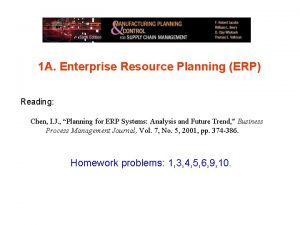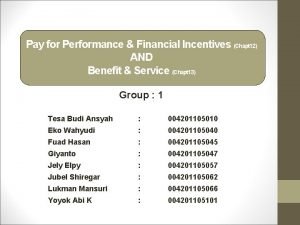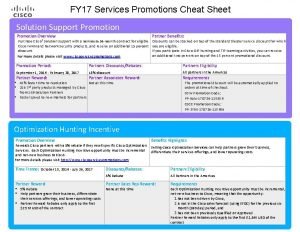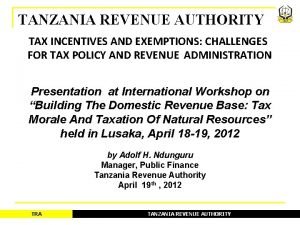The effects of shortterm cash and food incentives











![Participants assessed at 6 months Comparison 100% 80% [CELLRANGE] [VALUE] 60% Intervention [CELLRANGE] [VALUE] Participants assessed at 6 months Comparison 100% 80% [CELLRANGE] [VALUE] 60% Intervention [CELLRANGE] [VALUE]](https://slidetodoc.com/presentation_image_h/07f8f006b08c4cf84c13dd2000cefa57/image-12.jpg)





- Slides: 17

The effects of short-term cash and food incentives on food insecurity and labor force participation among adults initiating ART in rural Tanzania CAROLYN FAHEY, PROSPER NJAU, NTULI KAPOLOGWE, WILLIAM DOW, AND SANDRA MCCOY JULY 25, 2017 9 TH IAS CONFERENCE ON HIV SCIENCE

Food insecurity is a barrier to HIV care Nutritional Status Food Insecurity Livelihood Activities Adherence & Retention Inadequate access to food of sufficient quantity and quality, or the inability to acquire food in socially acceptable ways. (UN, 2001) Weiser et al. 2011; Singer, Weiser & Mc. Coy 2015

Short-term cash/food assistance can improve ART adherence & retention Improved ART adherence & retention in care after 6 months of randomized cash/food incentives in Tanzania (Mc. Coy et al. 2017) ◦ MPR≥ 95%: 63% comparison vs. 85% cash(P<0. 01), 79% food (P<0. 01) Other evidence: ◦ Zambia (Cantrell et al. 2008, Tirivayi et al. 2012) ◦ Haiti (Ivers et al. 2010) ◦ Honduras (Martinez et al. 2014)

Limited understanding of pathways Nutritional Status Food Insecurity Livelihood Activities Cash/Food Assistance Adherence & Retention Weiser et al. 2011; Singer, Weiser & Mc. Coy 2015

Mixed evidence for effects of cash/food on food insecurity Food assistance ◦ Zambia ( adherence): weight ◦ Haiti ( visit attendance): food security, BMI ◦ Honduras ( adherence): food security, BMI ◦ Uganda: weight among ART naive, weight among ART patients Cash or economic assistance ◦ Malawi ( ability to obtain ARVs): food security No effect ◦ Kenya ( viral suppression): food security Positive effect Negative effect Cantrell 2008, Tirivayi 2012; Ivers 2010; Martinez 2014 & Palar 2015; Rawat 2010; Miller & Tsoka 2012; Weiser 2015

Study Objective To examine the effects of short-term cash and food incentives on food security, nutrition, and livelihoods. ◦ Protocol: Mc. Coy SI et al. BMC Infectious Diseases 2015; 15: 490. ◦ Trial Registration: Clinicaltrials. gov, NCT 01957917 ◦ Ethical Approvals: National Institute for Medical Research & UC Berkeley

Study Population and Setting PLHIV at 3 HIV primary care clinics in Shinyanga, Tanzania ◦ Inclusion criteria: ◦ ≥ 18 years ◦ Initiated ART ≤ 90 days before enrollment ◦ Food insecure (Household Hunger Scale, FANTA 2011) ◦ Exclusion criteria: ◦ Severe malnourishment (BMI<16 kg/m 2)

Study Design: Randomized Trial Comparison Standard of care • Nutrition assessment & counseling Intervention Cash • Monthly cash transfer • 22, 500 TZS (~$11) Food • Monthly food basket • 12 kg maize flour + 3 kg beans + 3 kg groundnuts (~$11) • Up to 6 consecutive months of support. • Conditional on attending scheduled visits.

Outcomes Food security ◦ Household Hunger Scale (HHS): severe hunger ◦ Household Food Insecurity Access Scale (HFIAS): score 0 -27 Nutritional status ◦ Body-mass index (BMI, kg/m²) ◦ Weight gain (kg) Participation in livelihood activities ◦ Currently working ◦ Functional limitation (inability to work due to illness) Poster Exhibitions: Expenditures (TUPED 1334), effect heterogeneity (TUPED 1299) USAID, Food and Nutrition Technical Assistance Project

Baseline Characteristics Overall (n=800) Study group Comparison Intervention (n=112) (n=688) Pa Demographics Age (years) Female Swahili is primary language No formal education Farmer (primary occupation) Clinical characteristics 37 (10. 3) 509 (64%) 489 (61%) 194 (24%) 405 (51%) 35 (9. 3) 73 (65%) 80 (71%) 23 (21%) 47 (42%) 37 (10. 5) 436 (64%) 409 (59%) 171 (25%) 358 (52%) 0. 05 0. 71 0. 02 0. 32 0. 05 CD 4 cell count (cells/μl) b WHO clinical stage 3 -4 210 (149) 453 (57%) 218 (160) 56 (51%) 548 (160) 397 (58%) 0. 58 0. 14 Data are mean (SD) or n (%). a. Chi-squared test for categorical variables and t-test for continuous variables. b. n=637.

Baseline Outcome Values Overall (n=800) Study group Comparison Intervention (n=112) (n=688) Pa Food security HHS: Severe HFIAS (0 -27) Nutritional status 328 (41%) 15. 9 (5. 2) 41 (37%) 15. 6 (5. 2) 287 (42%) 15. 9 (5. 2) 0. 31 0. 59 BMI (kg/m 2) b Weight (kg) Livelihood activities 21. 5 (3. 5) 56. 5 (9. 4) 21. 7 (3. 3) 58. 1 (10. 2) 21. 4 (3. 5) 56. 2 (9. 2) 0. 40 0. 04 462 (58%) 439 (55%) 72 (64%) 64 (57%) 390 (57%) 375 (55%) 0. 13 0. 60 Currently working Functional limitation Data are mean (SD) or n (%). HHS=Household Hunger Scale; HFIAS=Household Food Insecurity Access Scale; BMI=Body-mass index. a. Chi-squared (χ²) test for categorical variables and t-test for continuous variables. b. n=772.
![Participants assessed at 6 months Comparison 100 80 CELLRANGE VALUE 60 Intervention CELLRANGE VALUE Participants assessed at 6 months Comparison 100% 80% [CELLRANGE] [VALUE] 60% Intervention [CELLRANGE] [VALUE]](https://slidetodoc.com/presentation_image_h/07f8f006b08c4cf84c13dd2000cefa57/image-12.jpg)
Participants assessed at 6 months Comparison 100% 80% [CELLRANGE] [VALUE] 60% Intervention [CELLRANGE] [VALUE] 40% 20% 0% Clinical records abstracted Survey completed

Outcomes at 6 months Food security HHS: Severe HFIAS (0 -27) Nutritional status BMI (kg/m 2) Weight gain (kg) Livelihood activities Currently working Functional limitation Comparison estimate (SE) Intervention estimate (SE) P 13. 4% (0. 06) 10. 5 (1. 3) 10. 2% (0. 02) 10. 3 (0. 3) 0. 57 0. 86 22. 2 (0. 22) 2. 1 (0. 42) 22. 5 (0. 12) 2. 4 (0. 19) 0. 25 0. 61 72% (0. 07) 25% (0. 07) 72% (0. 02) 11% (0. 01) 0. 97 0. 02 Adjusted for baseline imbalances including age, language, occupation, and weight. Weighted using inverse probability of missing (IPW) 6 -month assessment.

Changes in outcomes

Limitations 1) Attrition. 2) Some self-reported outcomes. 3) Small effects of cash/food may be obscured by strong benefits of starting ART.

Discussion Cash and food incentives increased ART adherence and retention. Food security, nutrition and livelihoods improved within groups. Incentives did not augment these improvements. ◦ Except for significantly less functional limitation. Suggests that cash and food transfers acted primarily via the price incentive to increase ART adherence, rather than income effects. Future studies are needed to understand long-term effects, and mechanisms that may increase and sustain retention in HIV services.

Acknowledgements UC Berkeley Shinyanga Regional Medical Office Dr. Sandra Mc. Coy Dr. Ntuli Kapologwe Dr. William Dow Ms. Agatha Mynippembe Dr. Nicholas Jewell Dr. Nancy Padian Dr. Nancy Czaicki Financial Support NIH/NIMH: K 01 MH 94246, R 03 MH 105327 Ministryof Health, Gender, Community Development, Elderly and Children Dr. Prosper Njau
 Memory definition
Memory definition Shortterm housing
Shortterm housing Cash-in cash-out
Cash-in cash-out Cash to cash cycle time
Cash to cash cycle time Cash to cash cycle time
Cash to cash cycle time The essentials of effective budgeting do not include
The essentials of effective budgeting do not include Paid cash to replenish the petty cash fund
Paid cash to replenish the petty cash fund An endorsement indicating a new owner of a check
An endorsement indicating a new owner of a check Pay for performance and financial incentives
Pay for performance and financial incentives Meetings incentives conventions and exhibitions (mice)
Meetings incentives conventions and exhibitions (mice) Cisco incentives and promotions
Cisco incentives and promotions Unit 2 food food food
Unit 2 food food food Eltonian pyramid
Eltonian pyramid Tax incentives in tanzania
Tax incentives in tanzania Type of sales promotion
Type of sales promotion Fiscal incentives for industrial promotion (revised)-2013
Fiscal incentives for industrial promotion (revised)-2013 Work incentives network oregon
Work incentives network oregon Safeco instant incentives
Safeco instant incentives
































